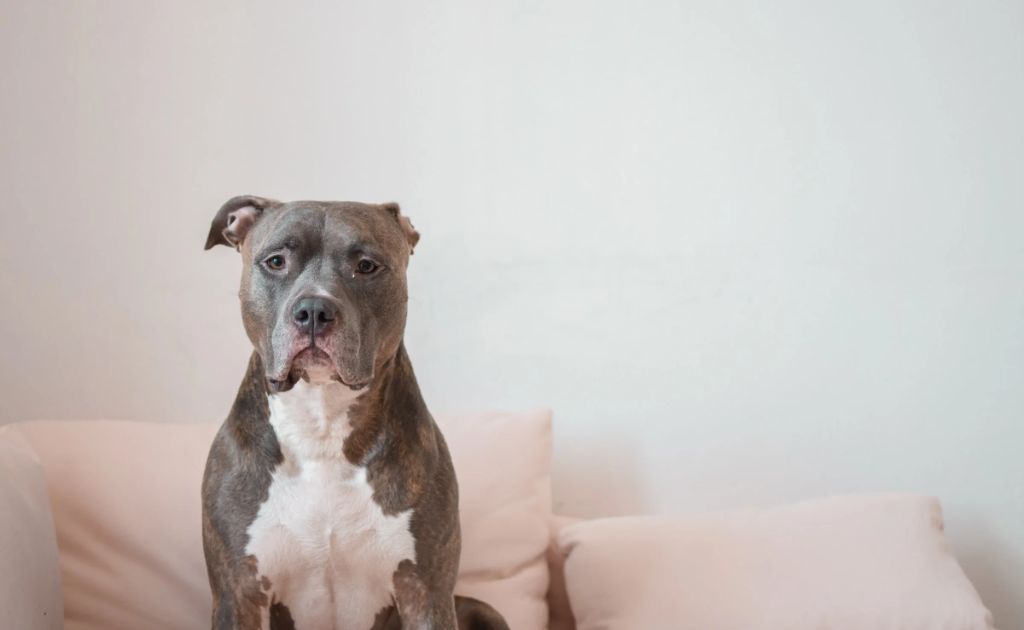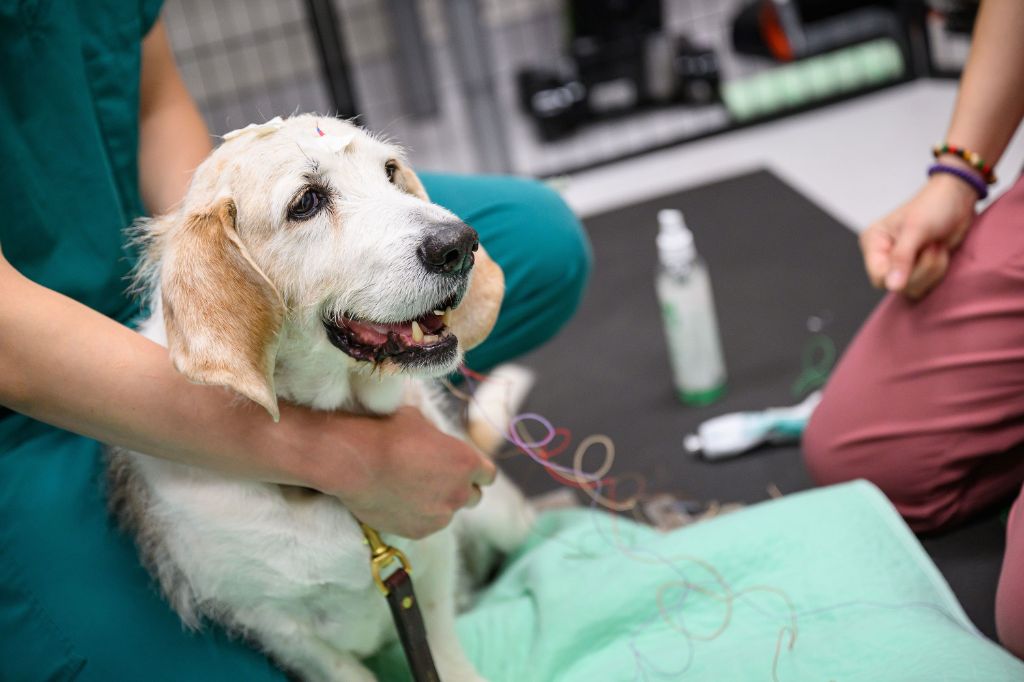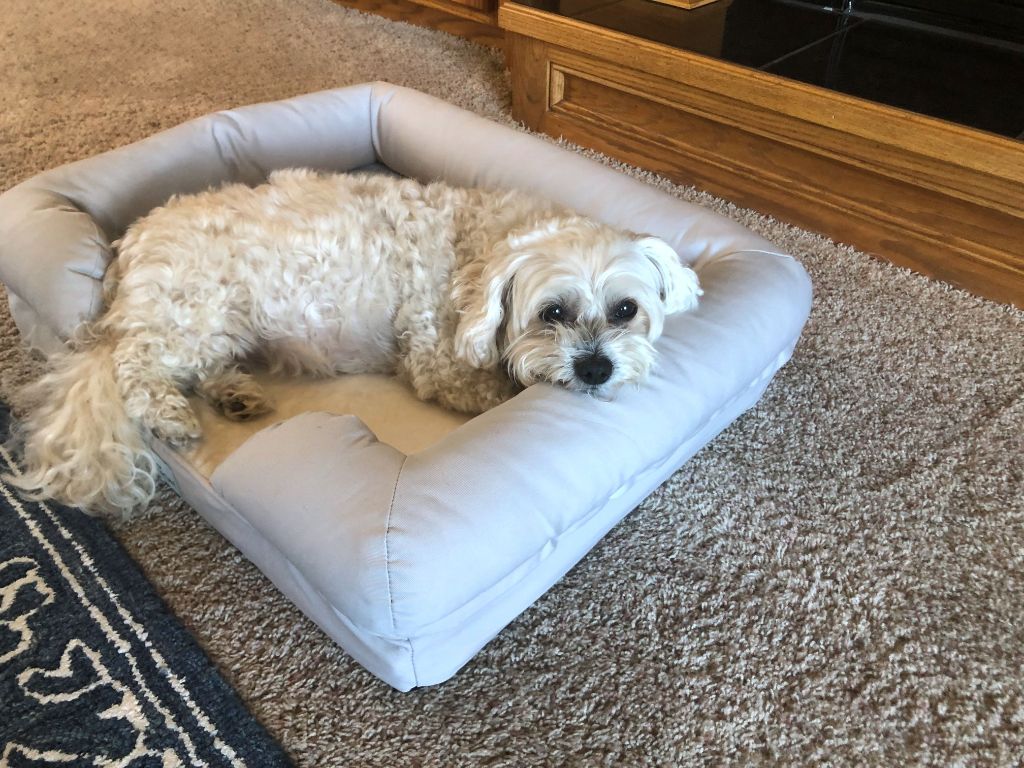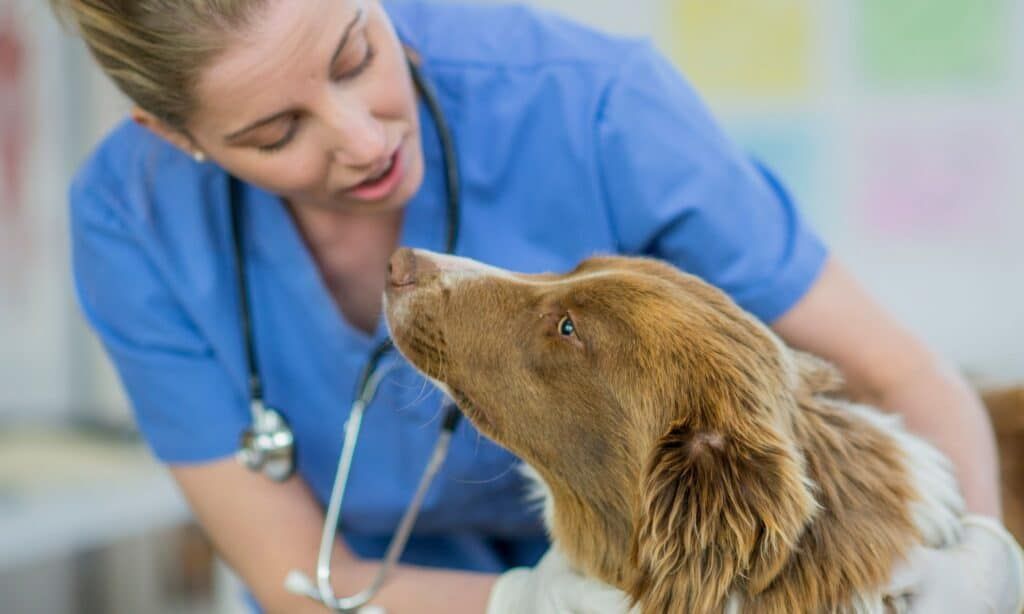The Meaning Behind the Stare
It can be concerning when your senior dog stares blankly into space or at walls for extended periods. This behavior is often a sign of canine cognitive dysfunction (CCD), which is essentially dementia or Alzheimer’s for dogs. As dogs age, their cognitive functions tend to decline, leading to disorientation, confusion, anxiety, and impaired memory and learning. Staring blankly can indicate that your dog is disconnected from their surroundings and experiencing episodes of dementia.
Vision loss or impairment is another common reason for staring in senior dogs. Conditions like cataracts, glaucoma, and progressive retinal atrophy can affect eyesight, making it difficult for dogs to see clearly. They may stare blankly as they try to make sense of a blurry world. Checking with your vet about your dog’s eyes and vision is recommended if staring is accompanied by bumping into furniture or walls.
Dogs may also stare due to fear or anxiety about unfamiliar sights, sounds, or events. Fireworks, construction noises, or changes in the home environment can sometimes cause nervous staring if dogs feel unsure about what is happening. Staring can be a calming mechanism for dogs when they feel anxious. Ensuring your home provides a safe and comforting space for an aging dog can help reduce nervous staring episodes.
In some cases, seizures can also lead to staring. If the staring is accompanied by muscle twitching, paddling motions, or unresponsiveness, urgent veterinary attention is required. Overall, any sustained, blank staring in senior dogs warrants checking with your veterinarian to rule out medical causes like CCD, vision issues, anxiety, or seizure disorders (Quora, 2022).
Signs of Canine Cognitive Dysfunction
One of the earliest signs of canine cognitive dysfunction is disorientation and confusion in familiar surroundings. Your dog may appear lost in your home, backyard, or neighborhood, especially in low light conditions. They may stare blankly or seem unsure of where they are despite being in a familiar location.

You may also notice changes in your dog’s social relationships. A dog with canine cognitive dysfunction may no longer eagerly greet family members or may fail to recognize people they know well. Increased anxiety, irritability, and changes in temperament around family and other pets can indicate mental decline.
Loss of housetraining is another hallmark sign of canine cognitive dysfunction. Previously housebroken senior dogs may begin having frequent accidents or lose the signal that they need to go outside. This is due to the changes happening in their brain.
Alterations in the normal sleep-wake cycle are also common. Your dog may pace, seem restless or agitated, or vocalize at night but then sleep more during the day. The loss of normal circadian rhythms reflects the degeneration occurring in the brain (Source).
Diagnosing Canine Cognitive Dysfunction
Getting an accurate diagnosis of canine cognitive dysfunction is important so that appropriate treatment can begin. There are several steps involved in properly diagnosing dog dementia:
Veterinary Exams – The first step will be a full medical exam, bloodwork and urinalysis by your veterinarian. They need to rule out any other medical conditions that could be causing the changes in your dog’s behavior. According to the Cornell University College of Veterinary Medicine, “Diagnosis of dementia in dogs must be done by a veterinarian, and the current means to do so is to rule out all other potential conditions.” [1]
Cognitive and Behavioral Tests – Your vet will assess your dog’s cognitive function and behavior changes. They will likely perform examinations to check your dog’s memory, awareness, recognition and more. The DISH examination is commonly used to evaluate signs of canine cognitive dysfunction. As Cornell explains, “A great place to start evaluating your dog for dementia is the DISH or DISHAA assessment. Basically, it gives you six areas to evaluate your dog’s cognitive abilities.” [2]
The diagnosis process aims to systematically rule out all other possibilities before determining that cognitive dysfunction is likely causing your dog’s behavior changes.

Treatment Options
There are several treatment options that can help manage the symptoms of canine cognitive dysfunction and improve your dog’s quality of life:
-
Medications – Drugs like selegiline and anipryl can help increase dopamine levels in the brain and reduce some of the behavioral symptoms associated with cognitive decline. However, medications may have side effects and should be discussed with your veterinarian.
-
Dietary supplements – Supplements containing ingredients like antioxidants, omega-3 fatty acids, medium-chain triglycerides, and S-adenosylmethionine (SAMe) may help reduce inflammation in the brain and slow cognitive decline. But evidence on their effectiveness is limited.
-
Environmental enrichment – Providing puzzles, toys, and activities that mentally stimulate your dog can help maintain cognitive function. Routinely changing up their environment and daily walks/exercise are also beneficial.
-
Routine exercise – Regular, moderate exercise may help improve blood flow to the brain and release neuroprotective compounds. But be sure not to overdo it for senior dogs. Low-impact exercise like short walks is best.
-
Training and games – Doing regular training sessions and playing games that require mental focus and problem solving can help keep your dog’s mind engaged. This type of mental stimulation is important.
Work closely with your veterinarian to determine the best treatment approach for your dog. The most effective plans often involve both medication and lifestyle/environmental changes.
Making Your Home Dementia-Friendly
As your dog’s cognitive abilities decline, making some adjustments around your home can help create a safe, comforting environment. Here are some tips for making your home dementia-friendly:
Clear paths through the home – Remove any clutter or furniture obstacles that could confuse your dog or make navigation difficult. Create clear pathways between your dog’s bed, food and water bowls, and their preferred potty areas.
Night lights – Increased anxiety and disorientation at night is common with canine dementia. Placing night lights along your dog’s pathways can provide a sense of security and help them find their way.
Easy access to food/water – Place food and water bowls in easy to access areas. Consider elevating the bowls to make eating and drinking more comfortable. Automatic water dispensers can ensure your dog stays hydrated.
Soft bedding – Older dogs with arthritis will appreciate thick, orthopedic beds. Wash bed covers frequently as incontinence can be an issue.
Limit access – Block off areas like stairs or high furniture your dog may struggle to navigate. Confine them to a small room when you’re away to prevent wandering and getting lost.
Comfortable temperature – Keep the temperature comfortable and consistent. Senior dogs are prone to being too hot or cold. (Source)

Keeping Your Dog Engaged
As dogs age, their minds and bodies slow down. Keeping your senior dog mentally and physically engaged can help stimulate their brain and prevent boredom. Here are some great ways to keep your older dog’s mind active and engaged:
Food puzzles like treat balls or snuffle mats provide mental exercise as your dog figures out how to get the treats out. Start with an easy puzzle and gradually increase the difficulty as your dog learns. Be sure to monitor in case your dog gets frustrated.[1]
Rotate new toys into your dog’s toy box frequently to introduce novelty. Avoid small toys that could pose a choking hazard. Interactive toys that dispense treats or make noise can pique your senior dog’s curiosity and interest.
Gentle exercise like short on-leash walks, swimming, or easy hikes keeps your dog’s body moving and mind engaged with new sights and smells. Adjust the exercise based on your dog’s physical condition.
Allow your senior dog to socialize and play with dog friends. This provides mental stimulation. Supervise play to ensure it doesn’t get too rough.
Involving your dog in your daily activities keeps their mind active. Include them when doing chores or errands they can handle.
Praise and treat your dog when they master a new skill or puzzle. This boosts their confidence and engagement.
Keeping your senior dog’s mind and body active improves their quality of life. Adjust activities based on your dog’s abilities and consult your vet if you have concerns.
[1]“Stimulating Toys for Older Dogs.” Purina, https://www.purina.co.uk/articles/dogs/senior/care/toys-for-senior-dogs.
Staying Patient and Providing Comfort
As your dog’s mental faculties decline, it’s important to stay patient and continue providing comfort and reassurance. Sticking to a routine can help create a sense of normalcy for your dog amidst the changes. Use gentle reminders if your dog seems confused about previously learned behaviors or struggles with accidents in the house. Provide plenty of affection and touch to help your dog feel safe and loved.
Some natural supplements may help soothe anxiety in senior dogs with dementia, but check with your vet first. Products containing L-theanine, chamomile, passionflower, and hemp oil can promote relaxation without sedating your dog. Always supervise supplement use and stop immediately if any side effects occur. The most important soothing remedy is your steady presence and compassion.
As challenging as dementia can be, remember that your dog is still the same beloved companion inside, simply needing a little more help. With patience, routine, and gentle care, you can continue providing your senior dog comfort and quality of life. For more tips, see 8 Tips for Caring for a Dog with Canine Dementia.
Working with Your Vet

If you suspect your senior dog may be experiencing canine cognitive dysfunction, it’s important to schedule an appointment with your veterinarian right away. Your vet will perform a full physical exam and diagnostic tests to rule out any underlying medical conditions that could be causing your dog’s symptoms (todaysveterinarypractice.com/neurology/management-of-dogs-and-cats-with-cognitive-dysfunction/).
If your dog is diagnosed with canine cognitive dysfunction, your vet will work with you to establish a customized care plan. This may include prescribing medications to help slow the progression of the disease, making diet changes, recommending supplements and nutritional therapies, and suggesting environmental modifications to support your dog’s changing needs (vcahospitals.com/know-your-pet/behavior-counseling-senior-pet-cognitive-dysfunction).
Your vet will want to monitor your dog’s condition over time to assess whether the treatment plan is working or needs to be adjusted. Follow-up appointments allow your vet to track the progression of your dog’s cognitive decline and make changes to maximize your dog’s quality of life (vet.cornell.edu/departments-centers-and-institutes/riney-canine-health-center/canine-health-information/senior-dog-dementia). Don’t hesitate to reach out to your vet if you notice new concerning signs or have any questions along the way.
Working closely with your veterinarian provides the best opportunity to support your senior dog through this challenging transition.
Considering Your Dog’s Quality of Life
As dogs age, especially with canine cognitive dysfunction, their quality of life can start to diminish. It’s heartbreaking to watch your once active, happy pup struggle with confusion, anxiety, and loss of previous abilities. While it’s normal for seniors to slow down, you want to ensure they still have more good days than bad.
With the right care tailored to your dog’s needs, many can continue enjoying life even with dementia. Simple changes like keeping routines consistent, securing exits, providing comfort items, and engaging their senses can make a big difference. But there may come a point when your dog’s quality of life declines to an unacceptable level.
Making that difficult decision to euthanize is part of being a responsible pet owner. It’s advised to consider euthanasia when your dog’s dementia results in a poor quality of life, significant loss of previous abilities, and more bad days than good. Continuing to deteriorate without any joy or comfort left is not fair to your loyal companion. While incredibly hard, many find euthanasia can be the final act of love and kindness.
Your vet can help assess your dog’s condition and advise if it’s time. Take solace knowing you provided the very best life possible to your dog – right up until the end.
Supporting Your Senior Dog
Dementia can be challenging but focusing on comfort and quality of life is important for senior dogs. As a dog owner, you play a crucial role in maintaining your dog’s quality of life. While there is no cure for canine cognitive dysfunction, there are ways to make your dog as comfortable as possible.
First, focus on keeping your dog’s environment consistent and familiar. Changes in routine can be disruptive and confusing for a dog with dementia. Keep furniture in the same place and stick to a regular schedule for feeding, walks, and playtime (Colostate Vet Med). Use gates, fencing or closed doors to limit access to parts of the home if needed.
In addition, keep interactions gentle and positive. Be patient if your dog seems lost or confused and avoid scolding. Engage your dog mentally and physically every day with short walks, joint supplements, massage, brushing and playtime. This provides comfort and fosters engagement. Consult your vet about puzzles, toys and rewards that encourage activity without frustration (VCA Hospitals).
Most importantly, focus on quality time together through petting, cuddling or just sitting nearby. Let your dog know they are safe and loved. This provides comfort and reassurance. With a little adjustment, you can continue to enjoy your senior dog and make their golden years happy ones.